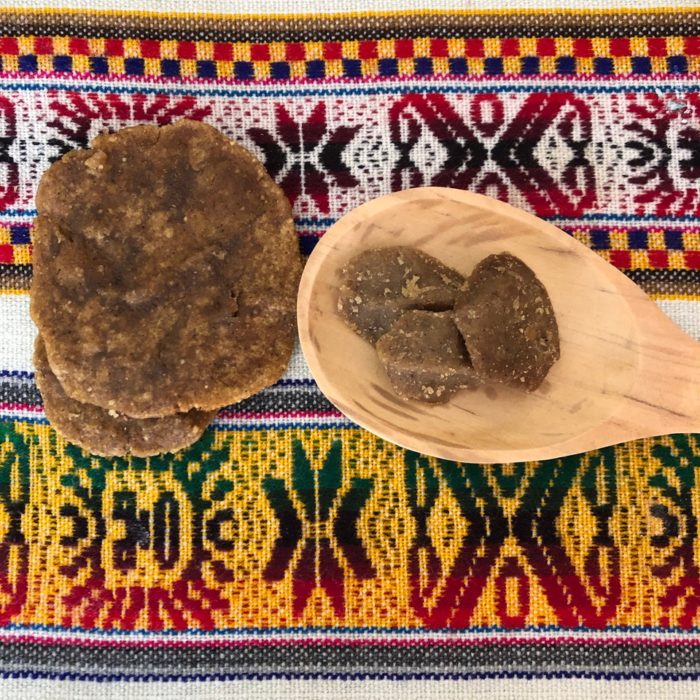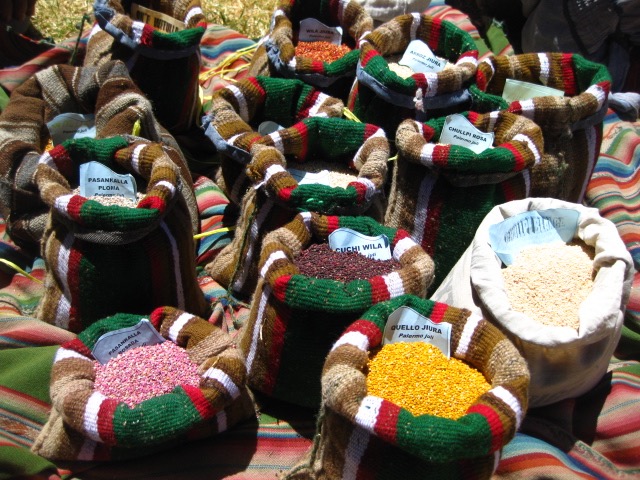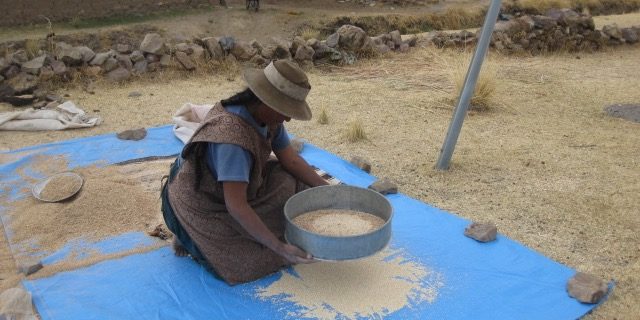Global Quinoa and Andean Foodways Part 2
Cover image: Farmer cleaning quinoa. Photo by Claudia Urdanivia
The following is the second part of a two-part report on Quinoa producers in the Andes. To read part one, click here.
Quinoa consumption also varies according to social differences and in urban or rural settings. Before its global popularity added to its prestige, quinoa was looked down upon as an “Indian food,” part of the legacy of colonialism and discrimination against indigenous people. Even though indigenous foods have been historically marginalized and undervalued, quinoa continues to have a place in the campesino diet. Moreover, quinoa’s international notoriety and recent commodification has brought renewed interest in Andean crops in rural communities. For example, various events and campaigns to promote quinoa consumption (like a “Regional Quinoa Day”)4 aim to shift popular perceptions of quinoa from an export commodity to a local food.
Quinoa export markets
With the initial excitement of the International Year of Quinoa, farmers were happy to benefit from high quinoa prices.5 But after prices began to decline in 2014, many felt that growing quinoa for the market did not justify the effort and investment required to produce it. In the aftermath of the quinoa boom, their strategy has been to intermittently sell small amounts of quinoa to either intermediaries or through their farmer’s association to gain a little extra income. Some Aymara farmers we spoke to referred to quinoa as a “caja chica” (petty cash) that they could turn to in case of emergencies or household needs.
Campesinos often engage in other activities in addition to agriculture, such as livestock farming and handicraft making, and their income is mostly unstable. With a little extra earning from quinoa sales, farmers are able to purchase school supplies and school uniforms for their children, buy fodder for their cattle, pay bills, purchase goods in the local marketplace and even invest in the education of their children. Incomes derived from quinoa varied greatly, particularly among farmers who had small landholdings compared to those who were renting their land. Those with the smallest landholdings, for instance, would direct most of the quinoa for home consumption.
For Aymara farmers like Luisa and Cesar who struggled to make a profit from quinoa, membership in a farmer’s association seemed like an attractive option. Some quinoa growers believed they could gain a better price by selling larger quantities to private firms, and that their product would be valued for its high quality and appreciated more if sold collectively. When they sold to intermediaries, farmers complained that their product would be mixed with lower-quality quinoa from other farmers who did not produce in the same way. Belonging to a farmer’s association could bring other benefits, like participating in local, regional, or even national festivals and fairs to sell processed quinoa products or present regional quinoa dishes in gastronomy contests. Luisa, for example, enjoyed participating in the association and the fairs that featured quinoa products and cooking demonstrations, as this allowed for her crop to be valued.

Kispiño, a traditional food made with quinoa. Photo by Fabiana Li
Stay in the loop with Food First!
Get our independent analysis, research, and other publications you care about to your inbox for free!
Sign up today!Farmers were also enthusiastic about belonging to an association because it could give them more leverage in negotiating the price of their quinoa and the organizations provided support and training. In order to access these benefits, however, farmers had to have the resources and knowledge to be capable of producing a high–quality product that met the demands of exporters. Farmers also needed to develop business and marketing skills, which were offered at trainings from NGOs and other rural development projects but were quite limited.
Some farmers thought they could sell their quinoa directly to an exporting company through an association, but this may not have been the case, as quinoa often passes through many channels before reaching its export destination. This lack of transparency in the quinoa commodity chain poses a challenge for farmers wanting to benefit from the increased demand for quinoa and for consumers wanting to support traditional quinoa-growing communities through the purchase of South American quinoa. While growing demand and higher prices for their product can generate gains for some producers, the export market does not provide a reliable source of income for small farmers who need it most.

Yellow, red, and other traditional varieties of quinoa are being displaced by the more commercial white quinoa. Photo by Claudia Urdanivia
Quinoa consumers in the global food system
What can the story of quinoa teach us about global food systems and our role as consumers? The increased popular awareness among consumers about where our food comes from and how it is produced is a positive development, but it often fails to capture the complexities of the food system while providing misguided solutions focused on market-based mechanisms (export production as good or bad) and individual consumer choices (eating quinoa or not).
As we have seen in our research, however, fluctuations in quinoa consumption in campesino communities does not relate solely to international demand. Consumption of quinoa is influenced by history, migration, globalization, and changing traditions. Dietary habits are also shaped by desires for convenience and less labor-intensive foods, changing tastes, and the availability of other foods (from imported products to a greater diversity of local goods available for purchase). The diets of campesino families could also be influenced by recent local and international efforts to promote quinoa products that are changing the value and meaning of quinoa in Andean communities.
In Puno’s quinoa-growing Aymara communities, the globalization of quinoa consumption has been a mixed blessing. In some cases, it has provided an additional source of income and motivation to grow a crop that had been disparaged and not given as much importance as it has today. But the increased commercialization of quinoa could have other consequences in the long-term: decreased biodiversity, as more farmers grow the commercial white quinoa instead of other native varieties, and more pressure on fertile land if it is used more intensively. As quinoa production also becomes more globalized, farmers in Puno are seeing increased competition from other regions and countries, with larger landowners growing primarily for the market. These challenges have led to a push by farmers to create a Protected Designation of Origin to safeguard and promote the special place-based characteristics of Andean quinoa.6
The limitations of market-based mechanisms to improve farmer’s livelihoods point to the importance of promoting quinoa consumption at the local and national level, as well as the need for agricultural policies and government programs that support small farmers. Some experts have suggested using local adapted quinoa varieties (landraces) to produce value–added products such as quinoa flakes, energy bars, flours, cookies, and much more. However, investing in these types of projects would be costly for farmers, who could benefit from more support from private and governmental agencies. Credit for farmers, insurance for crops, increasing the types of programs that support small business ventures by farmers, and increasing the number of extension agents to provide technical assistance support for farmers, are just some initiatives that would assist small quinoa producers.
Currently, the global food system disproportionately benefits retailers and large exporters, who make immense profits and have the most access to capital and power. The prices that farmers are paid for their crop erratically fluctuates based on supply and demand and when they are not connected to an entity that will pay a fair price for their crop (as is often the case), in worst case scenarios, farmers can end up spending more to produce than what they will earn by selling their crop. Global consumers should continue to demand a fairer distribution of profits that will benefit small farmers, promote sustainable agricultural practices, and increase transparency along the food chain. However, the idea that we can make a difference by buying or not buying a particular food like quinoa simplifies the multiple and sometimes untraceable nodes of the quinoa commodity chain. It also risks erasing the agency of Andean quinoa farmers who—by making decisions about when to grow, store, sell, or consume quinoa—seek to enhance their livelihoods and well-being within the constraints of our globalized food system.
Fabiana Li is a Peruvian-born anthropologist whose current research focuses on the politics of quinoa production. She is the author of Unearthing Conflict: Corporate Mining, Activism, and Expertise in Peru (2015) and articles on resource extraction and environmental conflicts in Latin America. She is an Associate Professor of Anthropology at the University of Manitoba, Canada.
Claudia Urdanivia is a community development practitioner and food systems professional. She is currently working for NYC Parks GreenThumb with community gardeners in the Bronx. She holds a Master’s Degree in Anthropology from Hunter College and has published in Anthropology Now about her fieldwork in her homeland of Peru, which centered on the local impacts of the global market expansion of quinoa.
4. Ascue Arostegui, Gloria Alcira. (2019, March 27). Exitosa participación de productores de la region Puno en el “Día Regional de la Quinoa 2019. Retrieved from https://www.agropuno.gob.pe/exitosa-participacion-de-productores-de-la-region-puno-en-el-dia-regional-de-la-quinua-2019/
5. McDonell, Emma (2018, March 12). The Quinoa Boom Goes Bust in the Andes. NACLA Report. Retrieved from https://nacla.org/news/2018/03/12/quinoa-boom-goes-bust-andes
6. Bolivia busca denominación de origen para la quinua y Perú sería desplazado. (2020, January 14). Retrieved from https://www.pachamamaradio.org/nacional/6133-bolivia-busca-denominacion-de-origen-para-la-quinua-y-peru-seria-desplazado


 Help Food First to continue growing an informed, transformative, and flourishing food movement.
Help Food First to continue growing an informed, transformative, and flourishing food movement.




